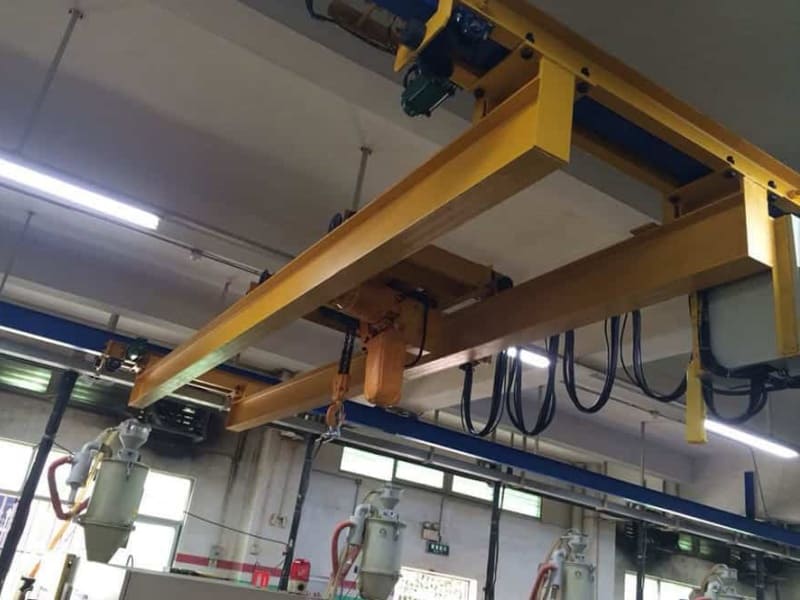When selecting an overhead crane system for your facility, one of the most important choices you will make is whether to install a top running bridge crane or an underhung bridge crane. Both belong to the family of EOT cranes (Electric Overhead Traveling cranes) and are widely used across industries for material handling. However, the two systems differ in design, load capacity, space utilization, and cost, making each more suitable for specific applications. Understanding these differences can help you make a well-informed purchase decision that maximizes efficiency and safety in your operations.
♦Design and Structure
A top running bridge crane operates on rails mounted on top of runway beams. This design allows the trolley and hoist to run on top of the bridge girders, giving them maximum lifting height and easier maintenance access. Top running systems can be built as single girder or double girder configurations, offering flexibility for different load capacities and span requirements. Because the trolley sits on top of the bridge, it provides excellent hook height, making these cranes ideal for heavy-duty lifting.
By contrast, an underhung bridge crane is suspended from the bottom flange of the runway beams. Instead of rails on top, the hoist and trolley travel beneath the bridge girder. This design is compact and well-suited to environments with low ceilings or limited headroom. While it generally restricts lifting height compared to top running systems, the underhung crane makes efficient use of horizontal space and can often be supported by the building’s ceiling structure, reducing the need for additional support columns.
♦Load Capacity and Performance
The top running bridge crane is the powerhouse of the EOT crane family. It can handle very heavy loads, often exceeding 100 tons, depending on the design. This makes it the preferred solution for demanding industries such as steel fabrication, shipbuilding, manufacturing, and large assembly lines. With a robust support structure, top running cranes deliver excellent stability and strength for large-scale lifting.
On the other hand, an underhung bridge crane is designed for lighter-duty applications. Typical lifting capacities range between 1 and 20 tons, making them perfect for assembly lines, small manufacturing workshops, maintenance tasks, and facilities where heavy lifting is not required. Although they lack the massive load capacity of top running cranes, underhung cranes offer speed, efficiency, and adaptability for lighter loads.
♦Space Utilization
Top Running Bridge Crane: Because it operates on rails above the beams, it requires strong support structures and ample vertical clearance. This can increase installation costs in facilities with limited ceiling height. However, the advantage is maximum hook height, which allows operators to lift loads closer to the roof and make full use of the vertical space.
Underhung Bridge Crane: These cranes shine in environments where vertical space is limited. Since the crane hangs from the structure, it can be installed without extensive runway supports. They are often used in warehouses, workshops, and production lines with tight clearances. In addition, underhung systems free up valuable floor space since they rely on overhead support.
Advantages and Disadvantages
Advantages:
-Handles very heavy loads, exceeding 100 tons.
-Offers wider spans and greater lifting heights.
-Provides easier maintenance access due to trolley position.
-Suitable for large industrial facilities and heavy-duty use.
Disadvantages:
-Requires robust structural support, raising installation costs.
-Less suited for facilities with low ceilings or limited headroom.
Advantages:
-Flexible and adaptable to different facility layouts.
-Lower installation costs because of lighter construction.
-Ideal for environments with restricted vertical space.
-Maximizes available floor space.
Disadvantages:
-Limited load capacity compared to top running cranes.
-Reduced hook height due to suspended design.
Choosing the Right EOT Crane
When deciding between a top running bridge crane and an underhung bridge crane, it is essential to consider your operational needs:
If your facility handles heavy-duty lifting tasks such as steel production, shipbuilding, or large-scale manufacturing, a top running system is the most efficient and reliable option. Its robust design, higher hook height, and wide span capabilities make it suitable for demanding operations.
If your facility deals with light to medium loads and operates in a space-constrained environment, an underhung system may be the better solution. With easier installation, lower costs, and space efficiency, underhung cranes provide a practical and cost-effective alternative.









